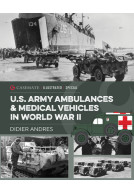Clearing the Way (Hardback)
U.S. Army Engineers in World War II
Pages: 208
Illustrations: 30–40 photographs and illustrations
ISBN: 9781636243863
Published: 30th November 2023
(click here for international delivery rates)
Order within the next 6 hours, 15 minutes to get your order processed the next working day!
Need a currency converter? Check XE.com for live rates
Quite simply, without engineers the U.S. Army would have been unable to fight World War II. The men of the Corps of Engineers, with the strength of more than 700 battalions mobilised during World War II, were tasked with every imaginable engineering challenge. In rear areas and back in the United States they built the facilities essential for everyday military life: showers, toilets, barrack blocks, military hospitals, training camps, storage depots, and much more. To keep logistics flowing to the front, they constructed or repaired thousands of miles of roads and bridges, plus built airfields to support Allied strategic and tactical air operations. Engineers also created endless chains of defensive positions, from simple trench systems to complex bunker networks, as well as retrieving damaged vehicles and equipment from still-contested battlefields.
Combat engineers, meanwhile, occupied some of the most dangerous frontline roles in the American armed forces. Heavily armed with demolitions and weapons, plus weighed down by engineering tools and even driving armoured bulldozers, they were tasked with destroying enemy strongpoints, bridges, equipment, vehicles and many other obstacles to the advance, in both overland and amphibious operations.
Building the Battlefield: Tactics and Techniques of U.S. Army Engineers in World War II brings together an exceptional collection of primary sources from engineering field manuals, technical manuals, and other official publications. They provide a detailed insight into the work and skills of the U.S. Army engineers, including building a field fortification, laying and defusing mines, making a contested river crossing, or camouflaging a defensive position properly. Through these texts, we gain practical insight into the exceptional individuals who often combined first-rate infantry fighting skills with engineering skill and problem-solving ingenuity.
"As the book says it comprises a collection of the engineering field manuals issued at the time, in order to explain to the reader the huge role that Military Engineers played during WW2. As a retired Royal Engineer it made a very interesting comparison to the UK manuals of that era that I have seen during my career."
Brian Smyth - York Model Engineers Newsletter
The introduction gives us some background to the US Corps of Engineers, which was founded as far back as 1802, which gives us a good idea of just how important the role of the military engineer has been to the work of the US Army. Rapid expansion in WW1 was followed by reductions in size afterwards thanks to demobilisation, but after events in France in 1940, there was again a rapid expansion in their numbers. By the end of the war in 1945 the numbers in the corps had expanded to 3/4 of a million men. Their contribution to the war effort was vital, everywhere the US Army served. Their roles were set out in the Engineers Manual. Each of the 6 chapters has an introductory text, followed by a selection of extracts from the various Field Manuals that were published for them to follow. These chapters take us through Engineer Roles and Units: Basic Skills and Engineer Equipment: Roads, Bridges and Airfields: Fortifications and Defenses: Explosives, Mines and Demolitions: and a final one on the Combat Engineer. Throughout the book the extracts from the manuals include archive photos along with explanatory diagrams. Clearly there is way too much for me to even attempt to try and tell you everything you'll find in here, but just to give a flavour of it all, there are mobile laundry units to operate, an intelligence bulletin comparing them to the German Pioniertruppen, basic tools and how to use them, organisational equipment, construction sites, bridging equipment and how to build them, terrain factors for building fortifications, airfields and camouflage for them all, sandbag walls, operating amphibious equipment, how to lay and/or disarm mines and much much more, all from original wartime material.
Military Model Scene
The level of detail provided to the troops who had to perform these vital tasks was clearly extensive, and all these extracts make for some very interesting reading. A marvellous collection of reference material which I think could interest historians, modellers and wargamers alike. I suspect plenty of ex-sappers may also still find this fascinating reading.
















